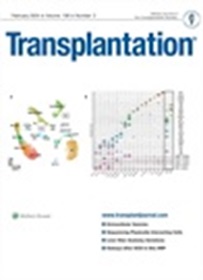Characterization of Baseline Lung Allograft Dysfunction in Single Lung Transplant Recipients.
IF 5.3
2区 医学
Q1 IMMUNOLOGY
引用次数: 0
Abstract
BACKGROUND Baseline lung allograft dysfunction (BLAD) is characterized by the failure to achieve normal baseline lung function after double lung transplantation (DLTX) and is associated with a high risk of mortality. In single lung transplant (SLTX) recipients, however, cutoff values and associated factors have not been explored. Here, we aimed to define BLAD in SLTX recipients, investigate its impact on allograft survival, and identify potential risk factors for BLAD in SLTX recipients. METHODS We performed a retrospective, single-center analysis of the LTX cohort of LMU Munich between 2010 and 2018. In accordance with DLTX cutoffs, BLAD in SLTX recipients was defined as failure to achieve percentage of forced expiratory volume in 1 s and percentage of forced vital capacity of >60% on 2 consecutive tests >3 wk apart. Survival analysis and regression analysis for potential predictors of BLAD were performed. RESULTS In a cohort of 141 SLTX recipients, 43% of patients met BLAD criteria. SLTX recipients with BLAD demonstrated impaired survival. Native lung hyperinflation was associated with BLAD in obstructive disease, whereas donor/recipient lung size mismatch was associated with BLAD in both obstructive and restrictive underlying diseases. Pulmonary function testing at 3 mo after lung transplantation predicted normal baseline lung function in SLTX recipients with obstructive lung disease. CONCLUSIONS BLAD in SLTX recipients is as relevant as in DLTX recipients and should generally be considered in the follow-up of LTX recipients. Risk factors for BLAD differed between underlying obstructive and restrictive lung disease. A better understanding of associated factors may help in the development of preventive strategies.单肺移植受者肺移植基线功能障碍的特征。
背景基线肺移植功能障碍(BLAD)是指双肺移植(DLTX)后未能达到正常的基线肺功能,与高死亡率风险相关。然而,在单肺移植(SLTX)受者中,尚未探究其临界值和相关因素。在此,我们旨在定义 SLTX 受者中的 BLAD,调查其对异体移植存活率的影响,并确定 SLTX 受者中 BLAD 的潜在风险因素。根据 DLTX 临界值,SLTX 受试者的 BLAD 定义为:在相隔 3 周以上的 2 次连续测试中,1 秒内用力呼气容积百分比和用力肺活量百分比未能达到 >60%。结果 在 141 名 SLTX 受试者中,43% 的患者符合 BLAD 标准。患有 BLAD 的 SLTX 受试者生存率下降。原肺过度充气与阻塞性疾病的 BLAD 相关,而供体/受体肺大小不匹配与阻塞性和限制性基础疾病的 BLAD 相关。结论 SLTX 受者的 BLAD 与 DLTX 受者的 BLAD 同样相关,在 LTX 受者的随访中一般应考虑到这一点。BLAD的风险因素在潜在阻塞性肺病和限制性肺病中有所不同。更好地了解相关因素有助于制定预防策略。
本文章由计算机程序翻译,如有差异,请以英文原文为准。
求助全文
约1分钟内获得全文
求助全文
来源期刊

Transplantation
医学-免疫学
CiteScore
8.50
自引率
11.30%
发文量
1906
审稿时长
1 months
期刊介绍:
The official journal of The Transplantation Society, and the International Liver Transplantation Society, Transplantation is published monthly and is the most cited and influential journal in the field, with more than 25,000 citations per year.
Transplantation has been the trusted source for extensive and timely coverage of the most important advances in transplantation for over 50 years. The Editors and Editorial Board are an international group of research and clinical leaders that includes many pioneers of the field, representing a diverse range of areas of expertise. This capable editorial team provides thoughtful and thorough peer review, and delivers rapid, careful and insightful editorial evaluation of all manuscripts submitted to the journal.
Transplantation is committed to rapid review and publication. The journal remains competitive with a time to first decision of fewer than 21 days. Transplantation was the first in the field to offer CME credit to its peer reviewers for reviews completed.
The journal publishes original research articles in original clinical science and original basic science. Short reports bring attention to research at the forefront of the field. Other areas covered include cell therapy and islet transplantation, immunobiology and genomics, and xenotransplantation.
 求助内容:
求助内容: 应助结果提醒方式:
应助结果提醒方式:


